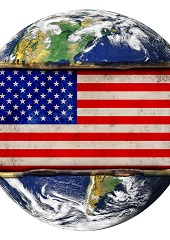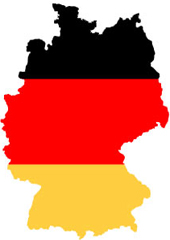Globalization, Americanization and Europeanization (Part I)
How well do the concepts of globalization, Americanization and Europeanization explain today’s world?
November 13, 2007

The three concepts of globalization, Americanization and Europeanization have been part of major arguments among scholars and practitioners for over 100 years. These debates, concerning the concepts’ usefulness, were rooted in a sense that the concepts encapsulated vital developments and forces in the world in which we live.
Economic historians have repeatedly drawn attention to the degree of globalization achieved before 1914 — a degree that was then disrupted by two world wars and profound economic crises, to be reached again only in the 1990s. Looking at trade statistics, human travel and population movements, it is indeed remarkable how interdependent the world had become by 1900.
The 19th century undoubtedly saw a great expansion and intensification of commercial exchange as well as the conquest and occupation of large territories in Africa, Asia and Latin America by the European powers in the “scramble for colonies.”
The invention of the telegraph and the laying of cables across the oceans connected continents at the speed of light and revolutionized communication. The building of very fast ocean liners reduced journey times across the Atlantic to less than a week. It was thus not just information that was constantly traveling around the globe electronically.
There was also the massive and growing exchange of goods along the great sea-lanes of the world, together with the movement of people. For several decades from the 1840s onwards, this movement involved the one-way journey to North America of millions of migrants from Europe across the Atlantic and from Asia across the Pacific. Others emigrated to Australia.
By the end of the 19th century, these streams of people began to dry up while business travel and tourism — especially between Europe and North America — increased dramatically. The Americans went because Europe was then still the acknowledged center of the world in economic, political and cultural terms.
The Europeans had set out long ago to “Europeanize” the world, often by means of commercial penetration, but also through brutal military force. But there was also little doubt that within the ensemble of the imperialist nations, Britain constituted the hegemonic power. For decades after the Napoleonic Wars, little could be done by the other powers that did not have at least the tacit approval of London.
However, by the late 19th century there were many signs that British hegemony was eroding and being challenged by its neighbors. In Europe, it was the ambition of Imperial Germany to overtake Britain not only as the leading commercial and industrial nation, but also in political and cultural terms.
William II, the German Kaiser, and his closest advisors were convinced that London would thwart their country’s rise to world-power status unless it was able to counter the Royal Navy’s dominance of the seas with the naval instrument large and efficient enough to defeat the British in an all-out battle in the North Sea.
Had William II succeeded in creating such a navy, it would have been followed by a major effort to “Germanize” the world. In the end, Germany proved too weak to challenge Britain militarily.
London successfully contained the German threat by engaging Berlin in an arms race that the Kaiser had lost by 1912/13. London also initiated countermoves, leading in 1904 to the formation of the Entente Cordiale with France — and, in 1907, to the inclusion of Russia in the Triple Entente.
The German refusal to accept its containment by Britain, France and Russia decisively contributed to the outbreak of World War I in August 1914. Five years later, not only had the German monarchy been defeated, but the de-Europeanization of the world had also begun. Even the once-almighty Britain emerged from the catastrophe as a second-rate power.
In the meantime, the United States had risen to the first rank — a development that could first be observed around the turn of the last century.
It was certainly no coincidence that the British journalist William T. Stead published an influential book in 1902 titled “The Americanization of the World or the Trend of the Twentieth Century.” No less significantly, this study appeared two years after the Paris World Exhibition at which the American pavilion became the great attraction for European businessmen, with the latest technologies and machines on display.
After Paris, more and more Europeans traveled to the United States to visit Washington, New York or Chicago, but also to inspect the centers of steel-making and steel-cutting in Pennsylvania, of the machine-tool and electrical engineering industries in Ohio and of car-making in Michigan.
Next to technology, they were particularly interested in American-style work organization as recommended by Frederick Taylor and in Henry Ford’s assembly lines in Detroit, the new automobile capital of the world.
From then on, North America was no longer regarded primarily as a continent of immigrant settlers, trappers, cowboys and “Red Indians.” What was still missing was the translation of this metamorphosis into a projection of American military power abroad.
The focus was still on the promotion of trade across the Atlantic, but also with the colonial world and exchange within Europe. In the years before 1914, Germany and Britain were each other’s best customers.
There were hence many businessmen and also some intellectuals and politicians who hoped that peaceful trade and free access to the markets of the world would relieve the tensions resulting from the great powers’ naval and military rivalries in an age of rising nationalism and economic protectionism.
In the end, the opposite happened. A militaristic nationalism overwhelmed economic internationalism and cultural cosmopolitanism that had inspired the pre-1914 globalization process. World War I, in which Europe’s colonial competition came back to haunt the region, so weakened its erstwhile hegemony that 1918 was tantamount to the end of Europe’s position at the center of the world. Britain’s pre-war position of preeminence was also gone.
Editor’s Note: Read Part II here.
Read previous

The New German Question
November 9, 2007
